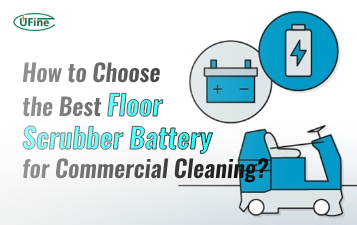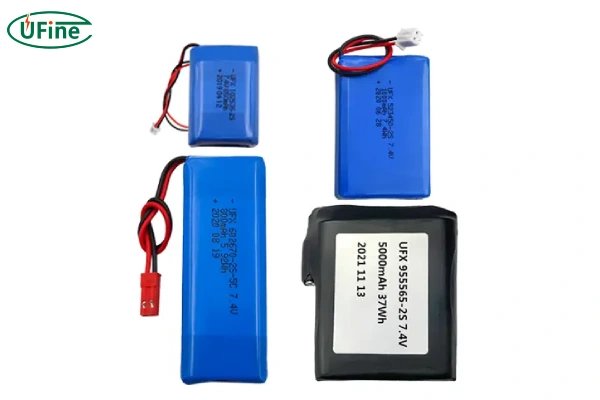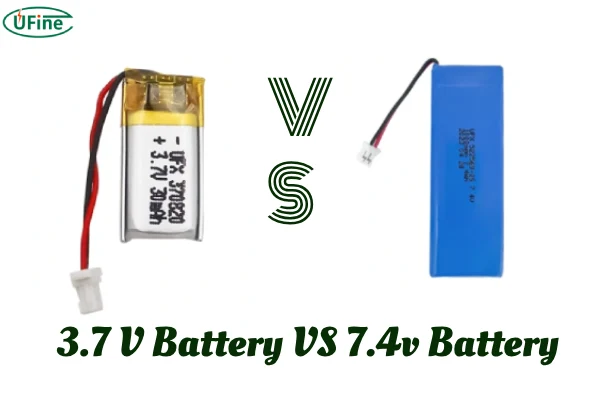Batteries power many of our gadgets. Among them, the 7.4V battery stands out. It’s found in various devices, from drones to RC cars. But what exactly is a 7.4V battery? This guide’ll dive into its details, differences from other batteries, how to make a battery pack, and more.
Part 1. What is a 7.4 V battery?
Part 2. 7.4 V lithium battery voltage
A 7.4V lithium battery has a nominal voltage of 7.4 volts. It’s commonly used in devices requiring more power than a single cell can provide. These batteries are typically made up of two 3.7V cells connected in series.
The voltage of a 7.4 V lithium battery will change under different conditions.
The voltage range of a 7.4 V lithium battery is generally as follows:
- Nominal voltage: 7.4V. This is the voltage output by the battery under ideal conditions, usually marked on the battery.
- Full voltage: about 8.4V. When the battery is fully charged, the voltage will reach its highest value, generally around 8.4V.
- Low voltage: about 6V. When the battery is exhausted, the voltage will drop to its lowest value, generally around 6V.
Why is there a voltage range?
- Battery chemistry: The voltage of a lithium battery is determined by the chemical reaction inside it. As the battery is charged and discharged, the degree of chemical reaction will change, resulting in a change in voltage.
- Temperature effect: Temperature also affects the voltage of the battery. Generally speaking, as the temperature increases, the internal resistance of the battery will decrease and the output voltage will increase slightly; as the temperature decreases, the opposite is true.
- Load effect: Different loads will affect the output voltage of the battery. The larger the load, the greater the voltage drop of the internal resistance of the battery, and the lower the output voltage will be.
Part 3. 7.4V battery vs. 7.4V LiPo battery vs. 7.4V Li-ion battery
Here are the key differences and connections between the 7.4V battery, 7.4V LiPo battery, and 7.4V Li-ion battery:
1. 7.4V Battery
- This general term refers to a battery with a nominal voltage of 7.4V.
- It does not specify the battery chemistry or cell type and could refer to a variety of rechargeable battery technologies.
2. 7.4V LiPo (Lithium Polymer) Battery
- A 7.4V LiPo battery is a specific type of rechargeable battery that uses lithium-polymer chemistry.
- LiPo batteries are known for their high energy density, compact size, and flexibility in shape.
- The 7.4V nominal voltage is typically achieved by connecting two 3.7V LiPo cells in series.
3. 7.4V Li-ion (Lithium-ion) Battery
- A 7.4V Li-ion battery is also a rechargeable battery that uses lithium-ion chemistry.
- Li-ion batteries are similar to LiPo in voltage and capacity but have a more rigid, cylindrical shape.
- The 7.4V nominal voltage is typically achieved by connecting two 3.7V Li-ion cells in series.
What’s the connection between them?
- Both 7.4V LiPo and 7.4V Li-ion batteries share the same nominal voltage of 7.4V, using two 3.7V cells connected in series.
- The main difference between LiPo and Li-ion is the battery chemistry and the shape.
- LiPo batteries offer more flexibility in shape and size, while Li-ion batteries have a more rigid, cylindrical design.
- Both 7.4V LiPo and 7.4V Li-ion batteries require specific chargers and protection circuits to ensure safe charging and discharging.
- The choice between a 7.4V LiPo battery and a 7.4V Li-ion battery often depends on the application, size, and power requirements of the device they will use.
Part 4. What is the difference between a 3.7v battery and a 7.4v battery?
The main differences between a 3.7V battery and a 7.4V battery are:
1. Voltage
- A 3.7V battery has a nominal voltage of 3.7 volts.
- A 7.4V battery has a nominal voltage of 7.4 volts.
2. Cell Configuration
- A 3.7V battery typically consists of a single lithium-ion or lithium-polymer cell.
- A 7.4V battery is typically made by connecting two 3.7V cells in series, resulting in a higher 7.4V output.
3. Energy Capacity
- A 3.7V battery will generally have a lower energy capacity (measured in mAh or Wh) than a 7.4V battery of similar physical size.
- The higher voltage of a 7.4V battery allows for greater energy storage in the same physical dimensions.
4. Applications
- 3.7V batteries are commonly used in small, portable electronic devices like smartphones, cameras, and vaping devices.
- 7.4V batteries are often used in larger, power-hungry devices like power tools, drones, and some RC vehicles, where the higher voltage and energy capacity are beneficial.
5. Charging Requirements
- 3.7V batteries require a single-cell charger.
- 7.4V batteries require a dual-cell or series charger that can properly balance and charge the two connected cells.
Part 5. How to make a 7.4V battery pack?
Here are the steps to make a 7.4V battery pack:
Materials Needed:
- 2 x 3.7V Li-ion or LiPo cells
- Battery holder or enclosure
- Spot welder or soldering iron
- Insulating tape
- Voltmeter or multimeter
Steps:
1. Check the Cells:
- Ensure the two 3.7V cells you use match capacity and condition.
- Measure the voltage of each cell to confirm they are at a similar state of charge.
- Using a spot welder or soldering iron, connect the positive (+) terminal of one cell to the negative (-) terminal of the other.
- This will create a 7.4V battery pack (2 x 3.7V cells in series).
3. Insulate the Connections:
- Wrap the exposed metal connections with insulating tape to prevent short circuits.
- Make sure there are no bare metal parts that could touch and cause a short.
4. Assemble the Battery Pack:
- Place the two connected cells into a battery holder or enclosure.
- Secure the cells in place and ensure they are protected from physical damage.
5. Add Battery Protection Circuit (optional):
- For added safety, you can install a battery protection circuit that will prevent overcharging, over-discharging, and overcurrent.
- The protection circuit should be connected in series with the battery pack.
6. Test and Charge the Battery Pack:
- Use a voltmeter to measure the voltage of the assembled 7.4V battery pack.
- Charge the battery pack using a compatible 7.4V charger or one designed for two Li-ion/LiPo cells in series.
- Monitor the charging process and ensure the cells are balanced during charging.
Part 6. How to charge a 7.4V battery?
- Identify the battery type: 7.4V is commonly used for lithium-ion or lithium-polymer (LiPo) batteries, common in devices like RC vehicles, drones, and some power tools.
- Use the right charger: You need a charger specifically designed for 7.4V LiPo batteries. Don’t try to use a charger meant for a different voltage.
- Connect the charger properly: The charger will have connectors that match the battery’s plugs. Make sure to connect the positive and negative terminals correctly.
- Set the charger settings: Most LiPo chargers will let you specify the battery voltage, capacity, and charging rate. Follow the manufacturer’s recommendations for your specific battery.
- Start charging: Turn on the charger and let it do its job. Typical charging times for a 7.4V LiPo are around 1-2 hours, depending on the battery size.
- Monitor the charge: Keep an eye on the charger to make sure the battery is charging properly without any issues.
- Disconnect when complete: Once the battery is fully charged, unplug it from the charger. Overcharging can damage LiPo batteries.
- Charger: The key things to remember are using the right charger, connecting properly, and not overcharging the 7.4V LiPo battery. Go slow and follow the manufacturer’s instructions for best results.
Part 7. 7.4V battery charger
Choosing the right charger for your 7.4V battery is crucial. Here are the types of chargers you might consider:
Types of Chargers:
- Standard Chargers: Basic models that provide straightforward charging. They are affordable but usually lack advanced features.
- Smart Chargers: These chargers come with features like overcharge protection, automatic shut-off, and indicators for charge status. They are a bit more expensive but offer peace of mind.
- Balance Chargers: Particularly important for 7.4V LiPo batteries, balance chargers ensure that each cell is charged equally, which is crucial for the battery’s performance and longevity.
Part 8. Can I use a 12V charger with a 7.4V battery?
No, you should never use a 12V charger with a 7.4V battery. A higher voltage charger can overheat the battery, potentially causing damage or even leading to a fire.
Part 9. Can I use an 11.1V battery instead of a 7.4V battery?
Substituting a 7.4V battery with an 11.1V battery is not advisable. The higher voltage can damage your device since it is designed to operate at 7.4V. Always follow the manufacturer’s specifications for battery replacements.
Part 10. Where is the 7.4 V battery used?
7.4V batteries are commonly used in a variety of applications, including:
1. RC (Remote-Controlled) Devices:
Radio-controlled cars, drones, helicopters, and airplanes often use 7.4V LiPo or Li-ion battery packs.
The higher voltage provides more power and runtime for these high-drain devices.
2. Power Tools:
Many cordless power tools, such as drills, saws, and grinders, utilize 7.4V battery packs.
The 7.4V voltage offers a good balance of power and runtime compared to lower voltage options.
3. Camera Equipment:
Some DSLR cameras, camcorders, and other professional camera gear use 7.4V battery packs.
The higher capacity and voltage help power the energy-intensive camera systems.
4. Military and Tactical Gear:
Military and law enforcement equipment, such as night vision goggles, communication devices, and tactical lights, may use 7.4V battery packs.
A reliable power source is important for mission-critical equipment.
5. Robotics and Automation:
7.4V batteries are used in various robotics and automation applications, including industrial robots, mobile robots, and automation controllers.
The voltage and capacity profiles are well-suited for the power demands of these systems.
6. Emergency and Backup Power:
7.4V battery packs are sometimes used in emergency lighting, backup power supplies, and portable power stations.
The higher voltage allows more power to be stored in a compact form factor.
Understanding 7.4V batteries, from their types and applications to how to make and charge them, can significantly enhance your tech game. Whether you’re powering a drone, an RC car, or another gadget, knowing the ins and outs of these batteries ensures you get the most out of your devices safely and efficiently. If you’re a DIY enthusiast, making your battery pack can be a fun and rewarding. Always handle batteries carefully, use the correct chargers, and follow manufacturer guidelines to ensure safety and longevity.
Related Tags:
More Articles

How to Choose the Best Floor Scrubber Battery for Commercial Cleaning?
Selecting the ideal floor scrubber battery ensures a long runtime, rapid charging, and minimal maintenance for efficient commercial cleaning operations.
Battery for Blower vs Battery for Leaf Vacuum: Which One Should You Choose?
Battery for blower vs leaf vacuum—learn the key differences in power, fit, and runtime to choose the right battery for your outdoor tool needs.
How to Choose the Right Battery for Blower?
Choosing the right blower battery? Consider voltage, capacity, chemistry & usage. This guide helps match the best battery for peak performance.
How to Choose the Best Insulated Battery Box for Lithium Batteries?
Choosing the Best Insulated Battery Box for Lithium Batteries? Discover key factors such as size, material, and safety for optimal protection and performance.
7 Critical Elements on a Lithium Battery Shipping Label
What must be on a lithium battery shipping label? Learn 7 key elements to ensure safety, legal compliance, and correct handling across all transport modes.






